by Tomas Blecha, Radek Soukup, Jan Reboun (1) and Miroslav Tichy (2)
1] Department of Technologies and Measurement, Faculty of Electrical Engineering, University of West Bohemia, Pilsen, Czech Republic
2] VUB, Usti nad Orlici, Czech Republic, tichy@vubas.cz
presented by T.Blecha at the 2nd PCNS 10-13th September 2019, Bucharest, Romania as paper 4.3.
Abstract
Wearable electronics and smart textiles are a rapidly developing area currently. Integration of electronic components and systems directly on/into textile substrates leads to the development of promising new technologies among which it is possible to include embroidering and knitting of passive electronic elements directly onto textile substrates. A hybrid conductive thread is the basic building block of these elements and it contains a different number and different kinds of metal fibers.
The article deals with a brief description of hybrid conductive threads and their specific applications in electronic systems. The article also includes the measured basic electrical and mechanical parameters of the described textile electronic elements where their long-term stability and resistance to routine maintenance (washing and drying) of textile substrates are also very important for these textile electronic elements.
Introduction
Nowadays, development of electronic systems is focused on flexible electronics that are easily integrated into smart systems such as smart textiles, RFID, smart cities, internet of things, etc. [1], [2], [3]. An important part of these systems is passive electronic components, sensors, buses and interconnection structures that have to meet requirements such as low price, simple, smaller size, lighter, flexible, planar and robust for the harsh environment. These requirements have led to the development of planar electronic devices created by the embroidery/knitting/weaving technology. These technologies can use electrical conductive threads that allow creating conductive patterns on the textile substrates (Fig. 1). Smart textiles are a very promising and dynamically developing field connecting textile materials and electronic components.
University of West Bohemia together with VUB company deal with research and development of hybrid conductive threads and their applications mainly for smart textiles. This leads to the interconnection of textile technologies with electronics and thus creating completely new useful products, particularly suitable in the following areas:
- Home care and health care
- Sport and fitness
- Well-being, IoT
- Protective clothing
Smart textiles are divided according to the degree of integration of electronic elements into textile substrates. The aim is to integrate these electronic components as much as possible into textile substrates. For this purpose, it is necessary to implement new elements on a textile basis with electrical properties. Between this basis elements, we can include conductive hybrid threads that can be used to implement some electronic components as part of textile materials.

Hybrid Conductive Threads
Passive electronic elements, sensors, bus, and interconnecting structures can be realized by a suitable construction of hybrid conductive or resistive threads by means of common technological processes known in the textile industry. The construction of hybrid conductive threads is based on ultrafine metallic wires combined with synthetic filaments like polyester or polyamide (Fig. 2). These threads have excellent electrical properties, esp. low linear electrical resistance (Tab. 1) that are given by used conductive material, diameter and number of conductive wires in threads. The particular metallic wire can be non-insulated or insulated (Fig. 3) based on used application. Developed hybrid conductive threads are fully compatible with standard textile manufacturing processes such as weaving, knitting and embroidering for creating of completely functional conductive tracks, circuits, textrodes, heating elements.
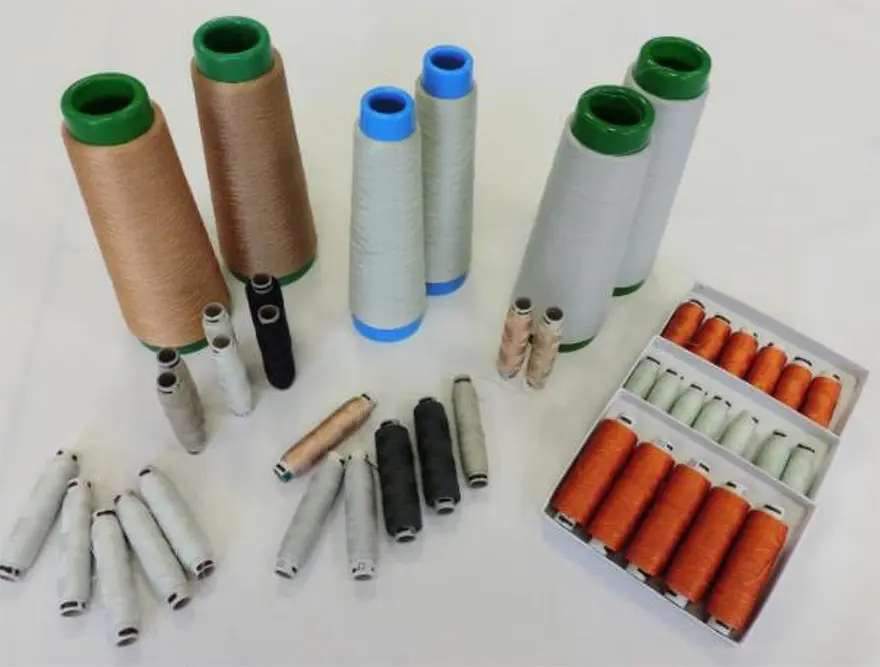

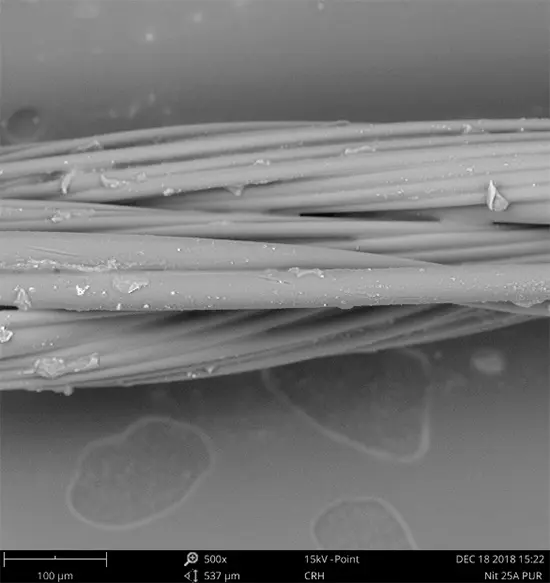
Tab. 1: Type of conductive threads and their parameters
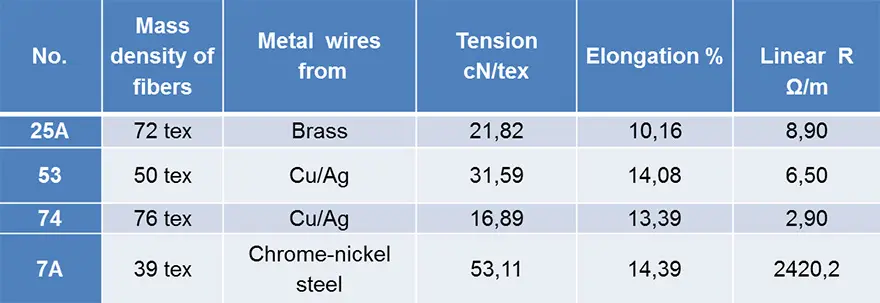
Conductive threads, which are based on silver-coated non-conductive polyamide fibers, have been available on the market for several years. These threads have better electrical parameters than hybrid conductive threads but their mechanical resistance is poor – about 20 washing cycles. The advantages of hybrid conductive threads are high mechanical resistance and resistance to washing/ drying process.
The performed tests show that these developed threads are resistant to washing process for more than 80 cycles. During the washing process, the resistance of the hybrid conductive threads are changed but in comparison with threads that are silver-coated, these changes are negligible (Fig. 4).
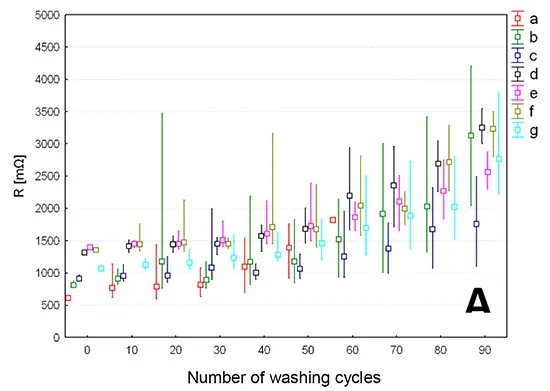
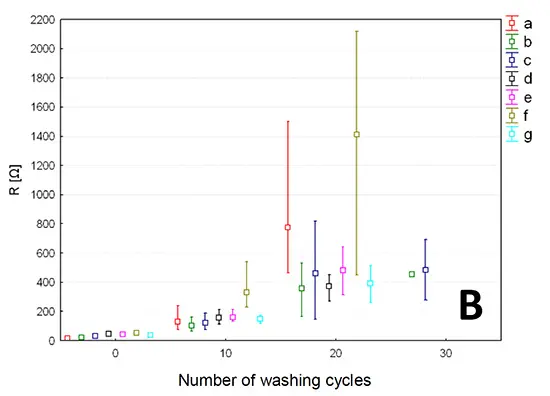
Applications of Hybrid Conductive Threads
Hybrid conductive threads that consist of different metallic wires with different numbers and diameters can be used for different electronic elements that are integrated directly into textile. Hybrid conductive threads allow to create simple but also more complicated electronic elements. The hybrid conductive threads can be used to implement textile bus and interconnect systems that can be both stretchable and flexible.
Passive electronic components and antennas
Using conductive threads, embroidered planar passive components such as resistors, inductors and capacitors or antennas can be easily implemented directly on textile substrates (Fig 5). These components are flexible, stretchable and washing resistance. By assembling these embroidered electronic elements, more complex electronic modules can be formed.
Textile buttons
The functional elements such as textile buttons can be created directly on textile substrates using hybrid conductive threads. In Figure 6, the example of capacitive textile buttons is presented. Capacitive textile buttons are created by embroidering technology. These buttons are interconnected with control electronic unit by also hybrid conductive threads. These buttons are used for switching of LED diodes that are connected on pads created by hybrid conductive threads. These LED diodes are soldered to these textile pads. The advantage of hybrid conductive threads is that can be soldered.
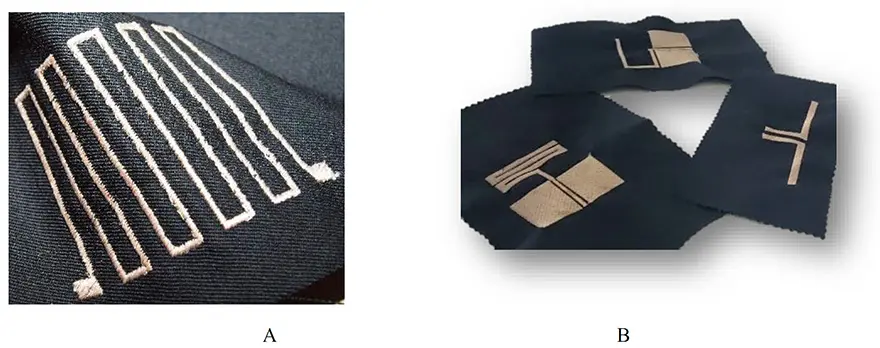

Sensors
Based on hybrid conductive threads the different type of sensors or sensor structures can be prepared. If the thread contains only one chrome-nickel steel wire, this thread can be used for the creation of temperature sensor on/in textiles [4]. The advantage of this sensor is its sensing area that can be modified and thus the sensor allows measuring temperature from a large area.
Because the thread has very low heat capacity, time response to sudden changes in the temperature is very fast. This textile temperature sensor has high mechanical resistance and resistance to washing/ drying process for more than 30 cycles. For the creation of this sensor, the standard textiles technologies can be used and it means very easy integration into textile.
For example, these textile sensors are suitable for patient temperature monitoring, early warning system against burns (steam burns, heat stress). Example of embroidered temperature sensor on the textile substrate and its measured temperature dependence of electrical resistance is shown in Figure 7.
Textile electrodes
Hybrid conductive threads can be also used for textile electrodes – textrodes. These electrodes can be prepared by knitting or embroidering and can be fully integrated into/on standard T-shirts. The commercially available evaluation electronics is connected via snap fasteners and allow to measure heart rate and ECG monitoring.
The advantage of these electrodes is in full integration in textile and so using of the external electrodes are not necessary. These textrodes do not prevent normal user movement. T-shirts with electrodes can be suitable during sports or for long-term patients monitoring for example in home care.
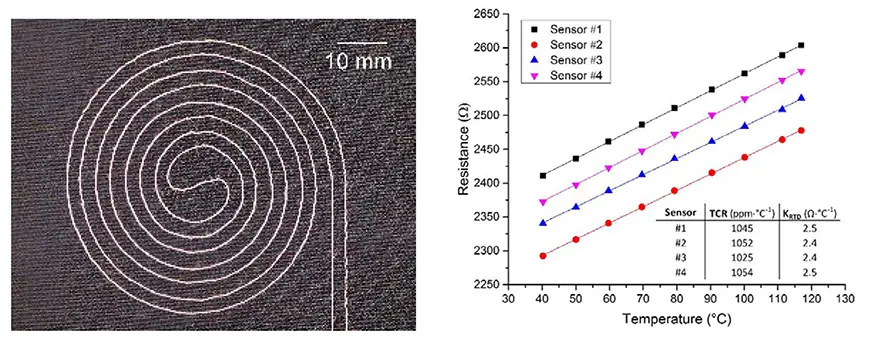

Conductive stretchable textile ribbons
Conductive stretchable textile ribbons mean that hybrid conductive threads are integrated into stretchable woven ribbons contain elastomer fibers. The stretchability of these ribbons is up to 70 % of the length. The ribbons can contain a different number of the conductive line with different number of conductive threads. In this way, the electrical parameters can be influenced.
The advantage of these ribbons is that the electrical resistance is stable during stretching. The ribbons can be in a version with insulated or non-insulated hybrid conductive threads. The textile ribbons withstand with conductive threads is more than 25 000 cycles for 30% stretching, more than 10 000 cycles for 50 % stretching and more than 9 000 cycles for 70% stretching.
Washing resistance is more than 50 cycles @ 400 rpm, 40 °C. If the conductive threads are on the surface of textile ribbons, the electronic components can be contacted and integrated by different technologies such as soldering, welding, and crimping on stretchable textile ribbons. These textile ribbons can be used for interconnection of electronic elements in/on textiles with conventional electronics elements or batteries.

Smart bed sheets
A smart bed sheet is designed to improve patient care not only in hospitals but also in home care. This bed sheet contains different hybrid conductive threads for temperature, humidity, presence sensors, and heating elements. Standard textile technologies are used for the production of low-cost smart bed sheet with seamlessly integrated micro-system which can monitor:
- Leakage of body fluids, excessive sweating
- Detect the presence of the patient in a bed
- Optionally monitor sleep quality based on movements
The bed sheet can be divided into different zones and each zone can be evaluated separately (Fig. 10). Particular zones are interconnected via knitted bus electrodes to the evaluation unit (Fig. 11). The data from the evaluation unit can be transmitted via WiFi or IoT networks (LoRaWAN, SigFox).
The other version of this smart bed sheet contains seamless integration of heating threads into a knitted structure that allows even temperature distribution (Fig. 12). The difference between the maximum and minimum temperature of heating lines is lower than 3 °C. Heating power can be up to 80 W. There is also possible to integrate temperature sensor based on hybrid conductive threads for feedback control of heating elements.
Both smart bed sheets have high mechanical resistance and resistance to washing/ drying process more than 30 cycles.
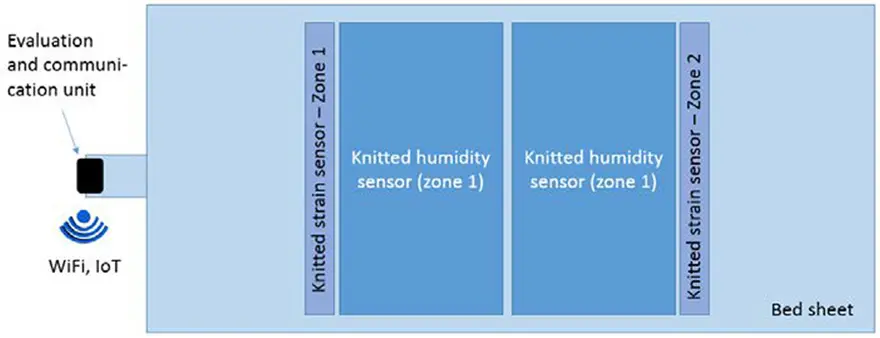
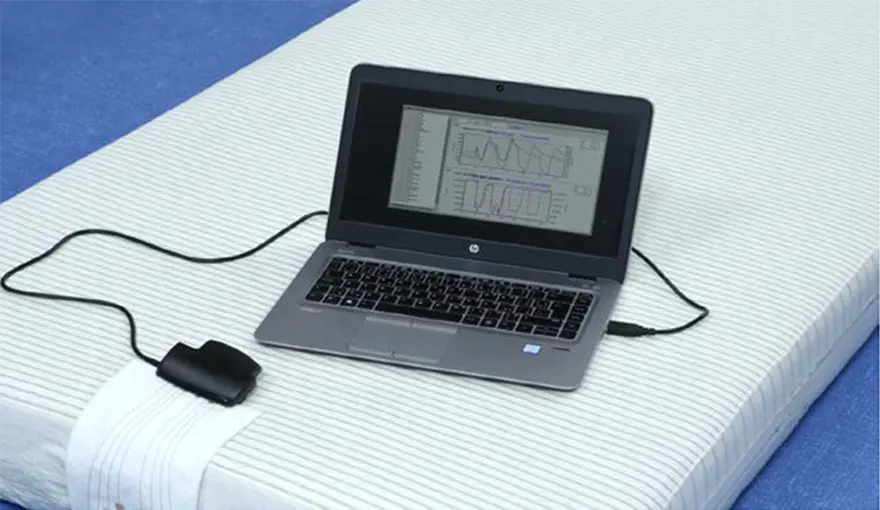
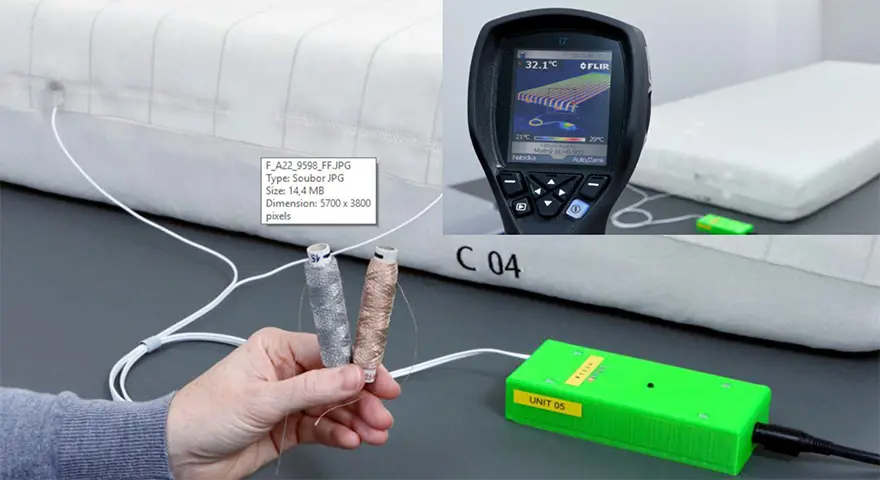
Smart socks
The idea of a smart sock is presented in Figure 13. Smart socks usefully integrated textile strain sensors for detection of limb swelling. The socks contain developed strain sensor threads based on stapled stainless steel fibers where the electrical parameters, mainly electrical resistance, are changed during stretching (Fig. 14).
These socks allow long-term measurement of swelling and its development over time. Particular strain sensors in the sock are connected with an evaluation unit by conductive stretchable textile ribbons (Fig. 13). Obtained data are wirelessly transmitted to the cloud using IoT platform.
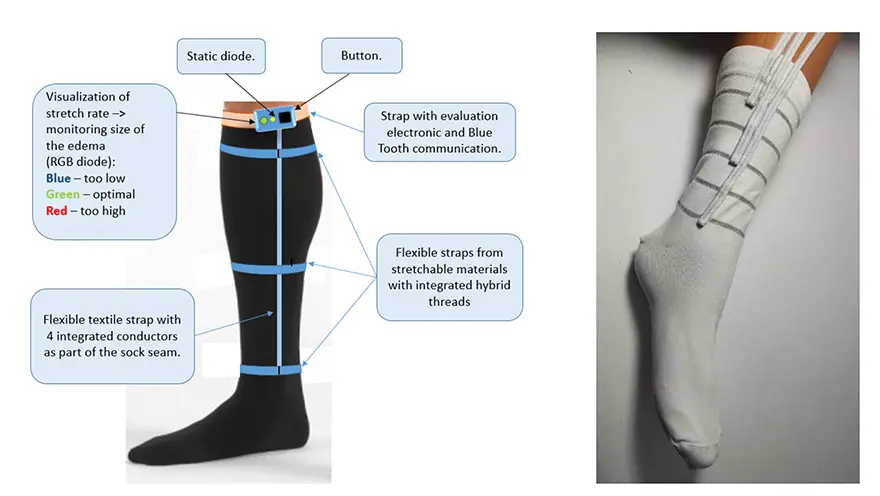

Conclusions
Nowadays, smart textiles are rapidly developing and allow the direct integration of various electronic elements directly into textile substrates. However, the biggest problem with these smart textiles is their resistance to routine maintenance such as washing and drying process.
Some products available on the market cannot be maintained by standard procedures or their lifetime decreases significantly. It is the development of hybrid conductive threads that enables the integration of a wide variety of electronic components, sensors and interconnecting structures with greater mechanical resistance to regular maintenance.
These threads can be used to construct simple but also more complex electronic elements in textile substrates. Only some applications of these conductive hybrid threads that are or will soon be on the market are presented in this article. However, there are other applications of conductive hybrid threads not mentioned here, especially in the field of protective clothing or in the treatment of certain diseases.
Acknowledgement
This research has been supported by the Ministry of Education, Youth and Sports of the Czech Republic under the RICE – New Technologies and Concepts for Smart Industrial Systems, project No. LO1607.
References
[1] MATTILA, H.R. Intelligent Textiles and Clothing. North America: Woodhead Publishing Limited, 2006.
[2] E-Textiles For Wearability: Review Of Integration Technologies. Textile World [online]. [cit. 2017-01-13]. Available from: http://www.textileworld.com/textile-world/features/2010/04/e-textiles-for-wearability-review-of-integration-technologies/
[3] SOFT SENSING STRUCTURES. Smart Textiles Design Lab Blog [online]. The Swedish School of Textiles, 2016 [cit. 2017-06-07]. Available from: http://stdl.se/?p=3864
[4] R. Polanský, et al., A novel large-area embroidered temperature sensor based on an innovative hybrid resistive thread, In Sensors and Actuators A: Physical, Volume 265, 2017, Pages 111-119, ISSN 0924-4247
more 2nd PCNS symposium technical papers can be viewed and downloaded in pdf from EPCI Academy e-Proceedings:

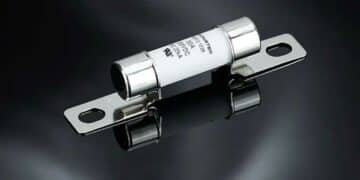

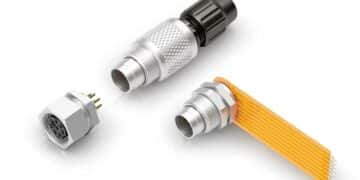



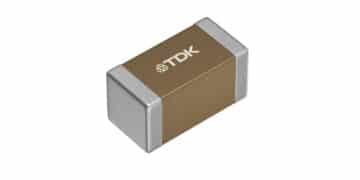


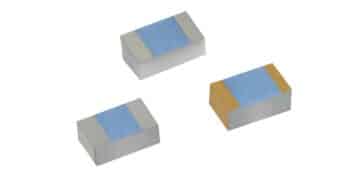










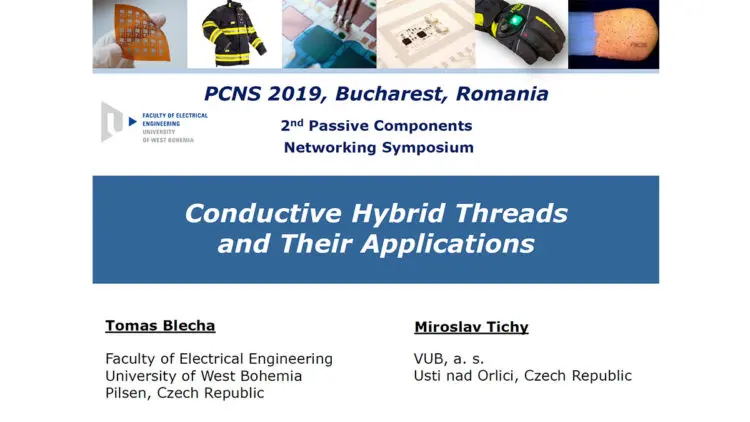
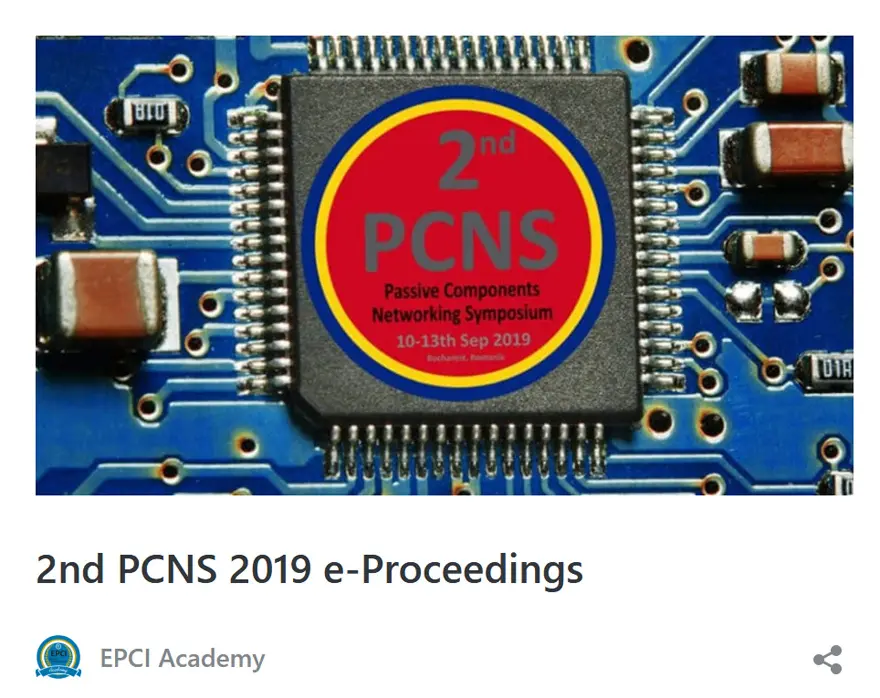




Discussion about this post